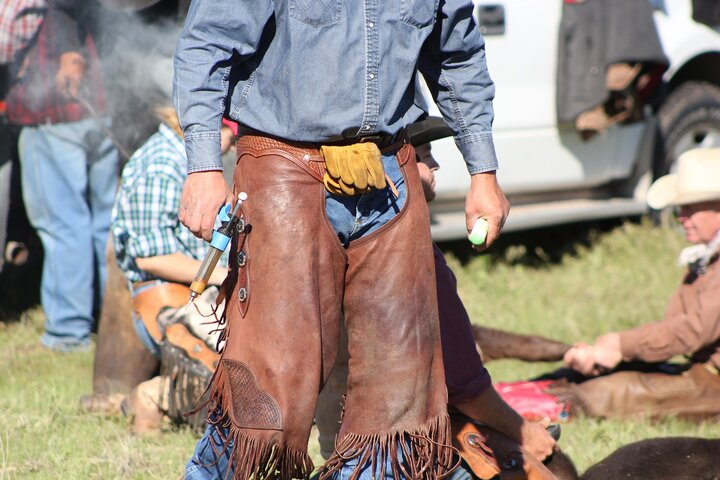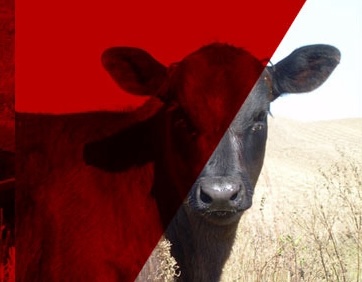Branding season has typically been about managing calves — identifying, castration, dehorning, and blackleg shots. In this article we would like for you to consider visiting with your veterinarian about adding a few more management activities to the list.
Cow management activities
Let’s start with the cow … the most important influencer of health in a calf is being born to a healthy mother! It starts before she is bred. We will start this article at pre-breeding and not back into a detailed discussion of heifer/cow management. As you are gathering calves for branding, it is a perfect opportunity to influence the immunity of all your calves’ mothers.
The list of vaccines and procedures to consider visiting with your veterinarian about include the following.
Vibrio in oil
- Vibriosis (Campylobacteriosis) — a bacterial infection caused by Campylobacter fetus.
- Infertility or repeat breeding in cows and heifers
- Early embryonic death leading to irregular or delayed estrus
- Occasionally abortion, typically in the early stages of pregnancy
- This is a vaccine that has short immunity and must be given within 60 days of breeding.
Lepto
- Leptospirosis caused by Leptospira species
- Abortion, often in the last trimester
- Weak or stillborn calves
- Fever, lethargy, and jaundice in some cases
- A common vaccine included with many vibrio vaccines.
IBR (Infectious Bovine Rhinotracheitis)
- Respiratory disease: fever, nasal discharge, coughing, and red/swollen nasal passages
- Reproductive effects: abortion (typically in the second half of pregnancy) and infertility
- Eye infections: conjunctivitis (pinkeye-like symptoms)
- Neurological signs (rare)
- This is a disease many of us think most often about being associated with respiratory disease, but it affects the cow’s reproductive tract and in the worst case, causes abortion. Ask your veterinarian about using a modified live virus (MLV) vaccine. Unless indicated on the vaccine label, using a MLV IBR vaccine is not recommended in pregnant cows. But this is pre-breeding and none of the mothers of the calves you are gathering at branding are pregnant, so a MLV IBR vaccine is perfectly acceptable and most veterinarians consider the immunity stimulated by a MLV to be superior to the immunity stimulated by a killed vaccine.
BVD (Bovine Viral Diarrhea)
- Acute: fever, diarrhea, decreased milk production, nasal discharge, oral ulcers
- Reproductive effects: abortion, stillbirths, and birth defects (e.g., weak calves or cerebellar hypoplasia)
- Persistent infection (PI calves): weak immune system and poor growth
- Mucosal disease in PI calves: severe diarrhea, ulcers, and death
- This is another serious disease you should discuss with your veterinarian. If your cows have not been BVD-PI (Persistently Infected) tested, they should be and the sooner the better. It requires an ear notch sample to be submitted to the UNL Animal Diagnostic Laboratory. Your veterinarian can help you with the details. Visit with your veterinarian about using a MLV BVD vaccine. The discussion above about MLV vaccines and pregnancy applies to BVD vaccines as well.
BRSV (Bovine Respiratory Syncytial Virus)
- Respiratory disease: labored breathing, nasal discharge, coughing, fever, and rapid breathing
- Severe cases: secondary bacterial pneumonia
PI3 (Parainfluenza Type 3 Virus)
- Mild respiratory signs: coughing, nasal discharge, and fever
- Predisposes cattle to secondary bacterial infections such as pneumonia
- BRSV and PI3 are not serious diseases of adult cattle but your veterinarian may want you to booster their immunity in hopes it may lessen the impact of “Summer Pneumonia” in your calves. A MLV vaccine for these diseases is very safe, including the use in and around pregnant cows.
Internal parasites
- The recommendations for controlling or managing internal parasites is being reconsidered and researched by veterinarians. While we once wanted all internal parasites out of our cattle, today parasite experts tell us it may be best to have a low level of internal parasites in our cow herds. They call this “refugia” and this is a low level of parasites that have not been exposed to dewormers and therefore have no resistance to dewormers. For now, perhaps consider deworming only the thin cows pre-breeding when you gather the calves at branding.
Calf management activities
Now for the calves … visit with your veterinarian about the following.
Branding, identification, dehorning, and castration
- These have long been key activities at branding time. In a previous article, the use of Meloxicam was discussed to help mitigate the pain associated with branding, castration, and dehorning. Meloxicam is a prescription medication that has a long half-life so one dose will provide the longest pain relief of any medication we know of in cattle. The dose is just three aspirin-size tablets per CWT and in the previous article a home-made dosing device was described. Visit with your veterinarian about adding Meloxicam to your branding schedule.
Blackleg (Clostridial vaccine)
- Sudden death in otherwise healthy cattle (most common sign)
- High fever (if noticed before death)
- Swelling, typically in large muscle groups like the shoulders, thighs, or hips, that feels spongy initially and later becomes hard
- Crepitation (crackling sound) under the skin due to gas buildup in the muscles
- Lameness and depression (in cases that don’t progress rapidly)
- Skin discoloration over swollen areas, turning dark or black
- This is another key activity at branding time. Not all vaccines are created equal so visit with your vet about acquiring a high quality product.
- Your handling of vaccine is just as important. NEVER, let a vaccine freeze! NEVER shake a “bacterin” (killed bacterial vaccine) because shaking can cause some of the bacterial cells to break and release additional endotoxin that can cause a severe, sometimes deadly, vaccine reaction. Instead of shaking, rotate the bottle back and forth to mix a bacterin that has a layer of cells settled to the bottom of the vaccine bottle. It takes more time but the outcome could be worth the effort.
BVD-PI testing
- Test all the heifers born from the first heat cycle. These are most likely to be the biggest heifer calves you will work at branding, and will most likely be the group of calves from which you select your replacement heifers. BVD-PI testing these calves will pave the way to insure you don’t keep any BVD-PI positive replacement heifers.
- Test all the heifers born from the first heat cycle. These are most likely to be the biggest heifer calves you will work at branding, and will most likely be the group of calves from which you select your replacement heifers. BVD-PI testing these calves will pave the way to insure you don’t keep any BVD-PI positive replacement heifers.
IBR, BVD, PI3, and BRSV MLV vaccine
- Because it is pre-breeding and none of these calves’ mothers is pregnant, there is no danger to the cows from using MLV vaccines on your calves. At worst, a MLV IBR may affect the first heat cycle on a few cows, but the improved immunity produced by a MLV vaccine compared to a killed virus vaccine should be well worth considering. Again, visit with your veterinarian, but discuss selecting a high quality IBR, BVD, PI3, and BRSV MLV vaccine to give to your calves at branding.
- Because it is pre-breeding and none of these calves’ mothers is pregnant, there is no danger to the cows from using MLV vaccines on your calves. At worst, a MLV IBR may affect the first heat cycle on a few cows, but the improved immunity produced by a MLV vaccine compared to a killed virus vaccine should be well worth considering. Again, visit with your veterinarian, but discuss selecting a high quality IBR, BVD, PI3, and BRSV MLV vaccine to give to your calves at branding.
Bacterial pneumonia vaccines
- These vaccines have never been as effective as we need, but there are a few that have research data that suggests they may be worth considering. These include Once PMH® (either SQ or IN), Presponse HM®, and Pulmo-Guard PH-M®. These vaccines may aid in lessening the Summer Pneumonia issues in your herd and will be the first step in improving the calves’ bacterial immunity when pre-weaning vaccines are considered.
- These vaccines have never been as effective as we need, but there are a few that have research data that suggests they may be worth considering. These include Once PMH® (either SQ or IN), Presponse HM®, and Pulmo-Guard PH-M®. These vaccines may aid in lessening the Summer Pneumonia issues in your herd and will be the first step in improving the calves’ bacterial immunity when pre-weaning vaccines are considered.
Implants
- These are not included as often as they should be. A Ralgrow® or Synovex-C® will increase your weaning weight about 5% — if you are not considering implants you are leaving a lot of money on the table. Follow label directions which includes using in calves over 45 days of age and to never implant replacement bull calves.
Conclusion
One last comment, when you do your pre-breeding bull breeding soundness and Trichomoniasis testing, if you haven’t previously, BVD-PI test your bulls. You don’t want a disease-shedding bull out with your herd.
Branding time always reminds us of a hopeful future. Advanced planning with your veterinarian can make the future of your calves and cow herd look even brighter.
Topics covered:
Cattle health & BQA, Vaccines & medications, Cattle health, Management & best practices

